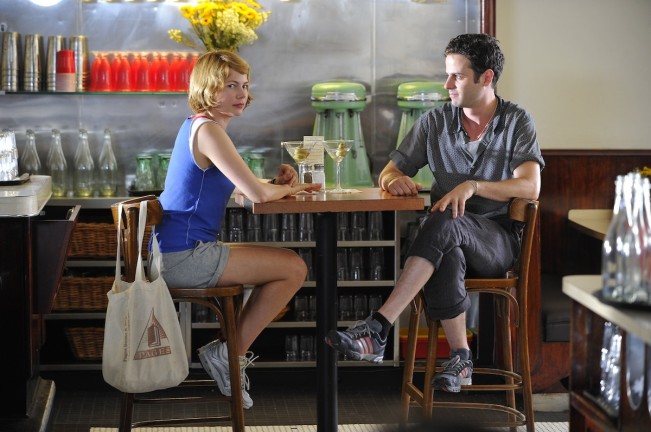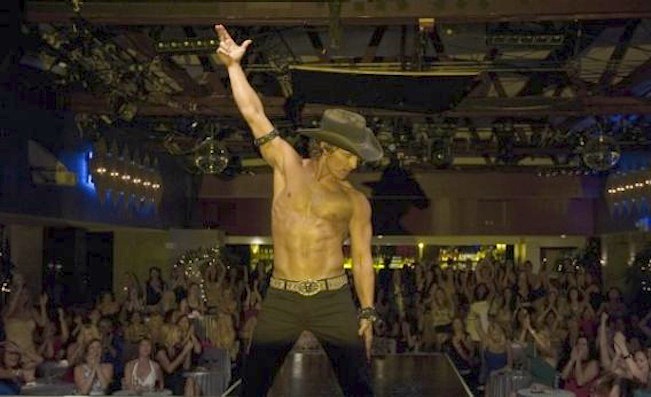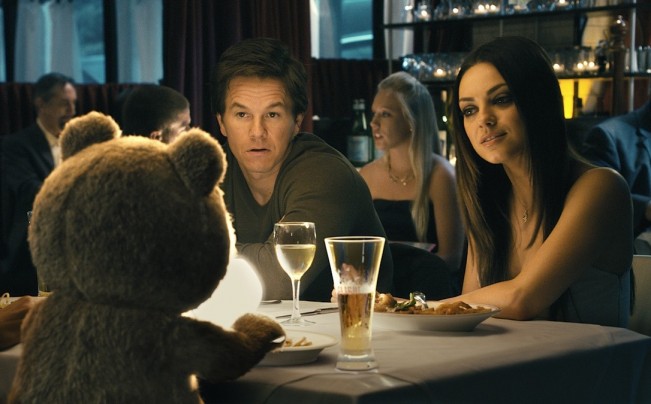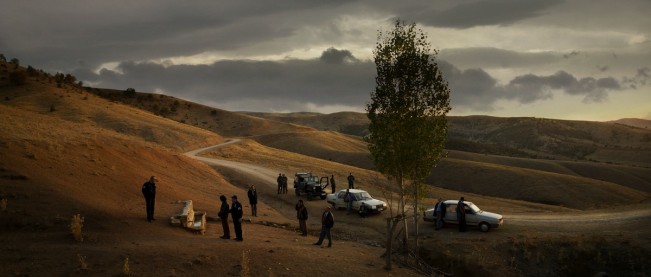

By Ray Pride Pride@moviecitynews.com
Pride’s Friday 5 (June 29, 2012)
1. Take This Waltz
 Take This Waltz is a daringly ambivalent, emotionally rich drama about the shoals of a stagnant marriage, the crashing waves of new attraction. It’s also writer-director Sarah Polley‘s love letter to a bedraggled Michelle Williams, who plays Margot, a drowsy young woman whose life hasn’t come into focus for herself. She’s been married five years to Lou (Seth Rogen, serious), a cookbook writer forever testing chicken recipes, filling the house with scent if not savor. While on a distant writing assignment, she meets another man, Daniel (Luke Kirby), whom she thinks she won’t see again, then sees him on the plane, shares a cab, then finds out he lives directly across the street. Hiding his art, driving a pedicab, he keeps his distance: the middle distance. The tease of the improbable and the undesirable and the so undesirable plays out. As a screenwriter, Polley is as pointillist as a short-story writer and as bold as a signboard painter: big and little gestures mix in winning measure. (“Five-point-oh quakes in the Provinces,” the television news reports.) Everything’s ripe and boldly colored. Luc Montpelier’s cinematography is as lucid (and lucent) as Polley’s generosity to her characters. And to costume designer Lea Carlson, who provides Margot with a succession of audacious yet telling summer garb, from one particular white-pinspot-on-red summer dress to a range of warmly colored tees, skirts, short-shorts and espadrilles and sandals.
Take This Waltz is a daringly ambivalent, emotionally rich drama about the shoals of a stagnant marriage, the crashing waves of new attraction. It’s also writer-director Sarah Polley‘s love letter to a bedraggled Michelle Williams, who plays Margot, a drowsy young woman whose life hasn’t come into focus for herself. She’s been married five years to Lou (Seth Rogen, serious), a cookbook writer forever testing chicken recipes, filling the house with scent if not savor. While on a distant writing assignment, she meets another man, Daniel (Luke Kirby), whom she thinks she won’t see again, then sees him on the plane, shares a cab, then finds out he lives directly across the street. Hiding his art, driving a pedicab, he keeps his distance: the middle distance. The tease of the improbable and the undesirable and the so undesirable plays out. As a screenwriter, Polley is as pointillist as a short-story writer and as bold as a signboard painter: big and little gestures mix in winning measure. (“Five-point-oh quakes in the Provinces,” the television news reports.) Everything’s ripe and boldly colored. Luc Montpelier’s cinematography is as lucid (and lucent) as Polley’s generosity to her characters. And to costume designer Lea Carlson, who provides Margot with a succession of audacious yet telling summer garb, from one particular white-pinspot-on-red summer dress to a range of warmly colored tees, skirts, short-shorts and espadrilles and sandals.
“I’m afraid of connections… in airports. I don’t like being in between things… I’m afraid of being afraid,” Margot confesses at one point. Her clothes always assert: I’ve arrived; I’m here, aren’t I? It’s all tragi-romantic: Take This Waltz feels like the film equivalent of a Nouvelle Vague cover of a familiar tune, but seductive in wholly fresh fashion.
Take This Waltz opens June 29 at Sunshine Cinema and July 6 in Berkeley, San Francisco, Pasadena, Philadelphia, Chicago and other cities.
2. Magic Mike
 When the rare 35mm print is spied in the wild, the shipping cases often bear punning fake names; in the case of Magic Mike, we’d just seen “Slight Of Hand.” Magic Mike’s more than that, gratefully. It took under a second to want to love Steven Soderbergh’s latest farewell film and a fragment of a second that’s missing at the very very very very last shot of the movie seals it with a kiss. Opening with the 1970s Warner Bros. studio rollout—a wide screen filled with red with a white-on-black studio logo in its center—and the words, “Let’s fucking get it on tonight,” Mike immediately jabs: here, here’s a spirited try at what I can do with the mood of the 1970s Hollywood Renaissance. Lessons in place and pace offered by Altman and Ashby are immediately in evidence; there’s a loving embrace of Saturday Night Fever; as well as the passage of time being charted by Kubrick-like intertitles. Made for a reported $5 million, Magic Mike‘s copyright is held by “The Estate of Redmond Barry,” Redmond Barry being the birth name of the title character of Stanley Kubrick’s Barry Lyndon. (“Bare-it Lyndon”?) (Still, Kubrick never directed a line like “I don’t sport-fuck my brother’s stripper friends.”) More here.
When the rare 35mm print is spied in the wild, the shipping cases often bear punning fake names; in the case of Magic Mike, we’d just seen “Slight Of Hand.” Magic Mike’s more than that, gratefully. It took under a second to want to love Steven Soderbergh’s latest farewell film and a fragment of a second that’s missing at the very very very very last shot of the movie seals it with a kiss. Opening with the 1970s Warner Bros. studio rollout—a wide screen filled with red with a white-on-black studio logo in its center—and the words, “Let’s fucking get it on tonight,” Mike immediately jabs: here, here’s a spirited try at what I can do with the mood of the 1970s Hollywood Renaissance. Lessons in place and pace offered by Altman and Ashby are immediately in evidence; there’s a loving embrace of Saturday Night Fever; as well as the passage of time being charted by Kubrick-like intertitles. Made for a reported $5 million, Magic Mike‘s copyright is held by “The Estate of Redmond Barry,” Redmond Barry being the birth name of the title character of Stanley Kubrick’s Barry Lyndon. (“Bare-it Lyndon”?) (Still, Kubrick never directed a line like “I don’t sport-fuck my brother’s stripper friends.”) More here.
3. Ted
 The elemental vituperation of Ted, the grown-up, gone-to-seed walking-talking once-famous Teddy bear is of the same ilk as “persona” commenters on the internet, but of an advanced intelligence put to comic purpose. (Or Mel Gibson as an insult comic.) Ted remains a drinking, drug-abused, sexually randy boy-bear-man, describing “a dirty fuzzy” and other misprisions, including of a grocery checkout clerk, “I fucked her with a parsnip last week and I sold the parsnip to a family with four small children.” The economy and bounce of that line doesn’t earn diagramming, but at least a small salute and a choke of laughter. He’s not shy about his shortcomings, either, saying of one, “You know, I’ve written so many angry letters to Hasbro about that.” (There are throwaways an audience’s laughter will mask, including “I don’t sound that much like Peter Griffin!”) A notoriously sarcastic Twitter feed for a smaller distributor deleted the funniest reference I’ve read to Ted, which went, approximately, “This Friday, there’ll be a movie co-starring what every little boy in America wants on their lap, plus a Teddy bear.”) Seth MacFarlane frames Kunis either full-figure or in full close-up, and, yes, there is the obligatory Mila-in-a-towel-with-wet-hair scene. More here.
The elemental vituperation of Ted, the grown-up, gone-to-seed walking-talking once-famous Teddy bear is of the same ilk as “persona” commenters on the internet, but of an advanced intelligence put to comic purpose. (Or Mel Gibson as an insult comic.) Ted remains a drinking, drug-abused, sexually randy boy-bear-man, describing “a dirty fuzzy” and other misprisions, including of a grocery checkout clerk, “I fucked her with a parsnip last week and I sold the parsnip to a family with four small children.” The economy and bounce of that line doesn’t earn diagramming, but at least a small salute and a choke of laughter. He’s not shy about his shortcomings, either, saying of one, “You know, I’ve written so many angry letters to Hasbro about that.” (There are throwaways an audience’s laughter will mask, including “I don’t sound that much like Peter Griffin!”) A notoriously sarcastic Twitter feed for a smaller distributor deleted the funniest reference I’ve read to Ted, which went, approximately, “This Friday, there’ll be a movie co-starring what every little boy in America wants on their lap, plus a Teddy bear.”) Seth MacFarlane frames Kunis either full-figure or in full close-up, and, yes, there is the obligatory Mila-in-a-towel-with-wet-hair scene. More here.
4. The Amazing Spider-Man
 Andrew Garfield has been a Marvel in movies from Boy A, Never Let Me Go and Red Riding: 1974 and he’s no less good here, even if it’s hard to accept him as a high-school outsider like Peter Parker unless he’s full-on high-functioning Asperger’s, this implausibly unavailable good looker, a tall man in his twenties photographed as a Ramones-T-shirt-wearing boy beanpole with a quiff of near-sentient volume. And as his opposite number, Emma Stone, mad blonde, skin impossibly pale in digital capture, wide mouth, ponytail. Boots, skirt at mid-thigh, leggings above the knee, above boots. The whole movie’s an excuse not to get them in bed together, but simply in the same frame: the last shot of her face is like Méliès’ screen-filling moon if its eyes were flooded with pleasure instead of pain. The physical equipoise of these two captivates, especially in one scene in a high-school corridor where they fumble gamely, bravely, with gravity, as if speaking dance, as if dancing wit, shot largely in full figure. And Stone always with the beautiful, abashed smile: their gravity and charm grounds the familiar archetypes. (Her huge smile is The Amazing Spider-Man‘s most remarkable effect.) Watching, I wondered how, outside of Marvel-type origin tales, how emotions could be projected this large, this gleefully, this gainfully, in a modern American movie, and my mind landed on a single grand example. Spider-Man illuminates Moonrise Kingdom as a latter-day, duo/superhero origin myth. More here.
Andrew Garfield has been a Marvel in movies from Boy A, Never Let Me Go and Red Riding: 1974 and he’s no less good here, even if it’s hard to accept him as a high-school outsider like Peter Parker unless he’s full-on high-functioning Asperger’s, this implausibly unavailable good looker, a tall man in his twenties photographed as a Ramones-T-shirt-wearing boy beanpole with a quiff of near-sentient volume. And as his opposite number, Emma Stone, mad blonde, skin impossibly pale in digital capture, wide mouth, ponytail. Boots, skirt at mid-thigh, leggings above the knee, above boots. The whole movie’s an excuse not to get them in bed together, but simply in the same frame: the last shot of her face is like Méliès’ screen-filling moon if its eyes were flooded with pleasure instead of pain. The physical equipoise of these two captivates, especially in one scene in a high-school corridor where they fumble gamely, bravely, with gravity, as if speaking dance, as if dancing wit, shot largely in full figure. And Stone always with the beautiful, abashed smile: their gravity and charm grounds the familiar archetypes. (Her huge smile is The Amazing Spider-Man‘s most remarkable effect.) Watching, I wondered how, outside of Marvel-type origin tales, how emotions could be projected this large, this gleefully, this gainfully, in a modern American movie, and my mind landed on a single grand example. Spider-Man illuminates Moonrise Kingdom as a latter-day, duo/superhero origin myth. More here.
5. Once Upon A Time In Anatolia
 Simple, beautiful, refined, restrained, leisurely, languorous, as moving as the course of night to day and night to day, Once Upon A Time In Anatolia may be the finest film yet by the great Turkish director Nuri Bilge Ceylan (Distant, Climates). Superficially a slowed police procedural, most of which takes place in deepest night in rural Turkish hills along winding roads, ribbons of trackbacks, as a grumbling storm approaches, the film takes its dear time revealing its concerns, becoming more profoundly affecting as the telling progresses. Dust and rain and cigarette smoke are palpable. (Ceylan is a great admirer of the Greek director Theo Angelopoulos and his stately feats of duration and mobile camerawork, and when Angelopoulos could not get financing for his project, “The Other Sea,” the Turkish pupil arranged for the production of the film; his teacher was killed while shooting in Piraeus in January.) A prosecutor who is told he resembles Clark Gable, a young doctor, a police captain, a couple of grunt cops, a couple of confessed killers: their search for a gravesite in forbidding gloom is by turns comic and telling. Ceylan shoots digitally, and the range of dark-on-dark-on-dark, of blacks and grays, is something cinema had never seen before. Tan grasses undulant in damp wind; the beauty of a face revealed by the glow of an oil lamp. Lightning briefly illumines a face carved onto slate-like stone as one of the characters sneaks away for a leak: a gentle, non-celluloid burst of imagery.
Simple, beautiful, refined, restrained, leisurely, languorous, as moving as the course of night to day and night to day, Once Upon A Time In Anatolia may be the finest film yet by the great Turkish director Nuri Bilge Ceylan (Distant, Climates). Superficially a slowed police procedural, most of which takes place in deepest night in rural Turkish hills along winding roads, ribbons of trackbacks, as a grumbling storm approaches, the film takes its dear time revealing its concerns, becoming more profoundly affecting as the telling progresses. Dust and rain and cigarette smoke are palpable. (Ceylan is a great admirer of the Greek director Theo Angelopoulos and his stately feats of duration and mobile camerawork, and when Angelopoulos could not get financing for his project, “The Other Sea,” the Turkish pupil arranged for the production of the film; his teacher was killed while shooting in Piraeus in January.) A prosecutor who is told he resembles Clark Gable, a young doctor, a police captain, a couple of grunt cops, a couple of confessed killers: their search for a gravesite in forbidding gloom is by turns comic and telling. Ceylan shoots digitally, and the range of dark-on-dark-on-dark, of blacks and grays, is something cinema had never seen before. Tan grasses undulant in damp wind; the beauty of a face revealed by the glow of an oil lamp. Lightning briefly illumines a face carved onto slate-like stone as one of the characters sneaks away for a leak: a gentle, non-celluloid burst of imagery.
Ceylan gently characterizes these men by dress, class indicated by a scarf here, the cut of a topcoat there, and a stopover in a hospitable rustic village deepens the undercurrents. The quest doesn’t end with a body, but with day, and the eddying outward of the stories the men have told each other, peeled away like an onion, where at the center there are only the purest of tears nature can provide. An autopsy is accompanied by children’s cries on a nearby playground: so goddam blunt, it would seem; but so goddam true and startling and right. Once Upon a Time In Anatolia is nothing less than great.
Once Upon a Time In Anatolia is on DVD and Blu-ray. Ceylan’s splendid photography can be seen here.













